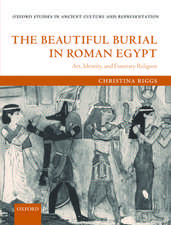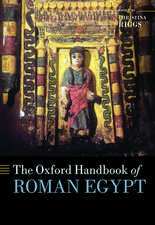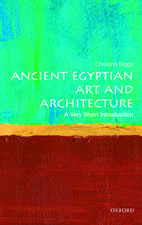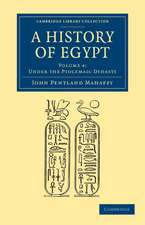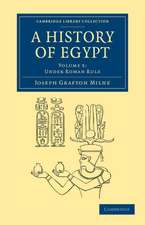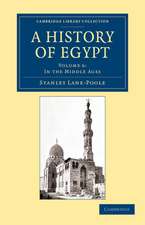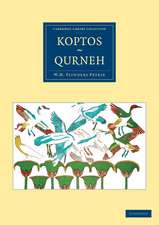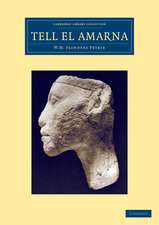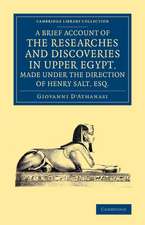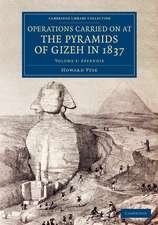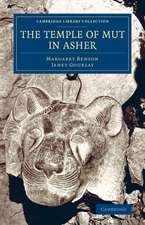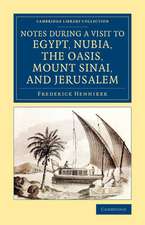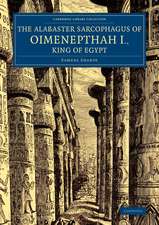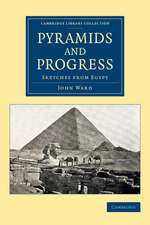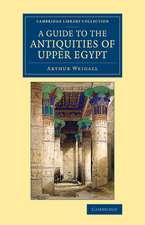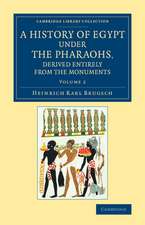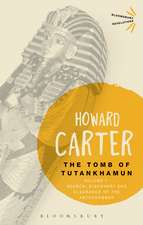Unwrapping Ancient Egypt
Autor Dr Christina Riggsen Limba Engleză Paperback – 9 apr 2014
| Toate formatele și edițiile | Preț | Express |
|---|---|---|
| Paperback (1) | 262.54 lei 6-8 săpt. | |
| Bloomsbury Publishing – 9 apr 2014 | 262.54 lei 6-8 săpt. | |
| Hardback (1) | 981.77 lei 6-8 săpt. | |
| Bloomsbury Publishing – 9 apr 2014 | 981.77 lei 6-8 săpt. |
Preț: 262.54 lei
Preț vechi: 314.71 lei
-17% Nou
Puncte Express: 394
Preț estimativ în valută:
46.46€ • 54.48$ • 40.80£
46.46€ • 54.48$ • 40.80£
Carte tipărită la comandă
Livrare economică 16 februarie-02 martie
Preluare comenzi: 021 569.72.76
Specificații
ISBN-13: 9780857855077
ISBN-10: 0857855077
Pagini: 336
Ilustrații: 68 bw illus
Dimensiuni: 156 x 234 x 15 mm
Greutate: 0.57 kg
Editura: Bloomsbury Publishing
Colecția Bloomsbury Academic
Locul publicării:London, United Kingdom
ISBN-10: 0857855077
Pagini: 336
Ilustrații: 68 bw illus
Dimensiuni: 156 x 234 x 15 mm
Greutate: 0.57 kg
Editura: Bloomsbury Publishing
Colecția Bloomsbury Academic
Locul publicării:London, United Kingdom
Caracteristici
Provides a rich cocktail of colonial history, archaeology and anthropology through an accessible, lively study
Notă biografică
Christina Riggs is a Senior Lecturer in the department of Art History and World Art Studies, University of East Anglia, UK.
Cuprins
List of IllustrationsAcknowledgmentsPrefaceDesecrationRevelationMummificationLinenSecrecySanctityAfterwordNotesReferencesIndex
Recenzii
Each chapter of this book represents one lecture from a series delivered in 2012 at All Souls College, Oxford .With 79 pages of notes and bibliography, the extensive research behind this book is well documented . The issues discussed go beyond the art historical. Riggs covers the psychology of entombing, hiding, and revealing in artistic, religious, and political contexts. Summing Up: Recommended. Upper-division undergraduates through researchers/faculty; general readers.
This is a work of passion, poetically written and convincingly argued, which highlights the crucial role played by textiles, wrapping and concealment in the structuring of ancient Egyptian society.
An original and powerful volume ... Riggs provides a (very) critical history of Egyptology and related curatorial practices. The result is a book that not only wears its erudition lightly, but also challenges the legitimacy and apparent exceptionality of what it is that Egyptologists do. Opening Egyptology's "black box," Riggs makes a major contribution to understanding what that box might contain, in addition to how this understanding might change our perceptions of "ancient Egypt" and scholarly practices related to it.
Dr Riggs' book contains much of interest, presented in an ingenious way that raises issues that might not otherwise have easily sprung to mind and which should indeed be considered by anyone dealing with the study of the ancient world.
Riggs is, undeniably, spot-on with many of her observations. She is deliberately provocative and hopefully this book - an affordable paperback that [could] reach a wide audience - will not simply be dismissed as 'trendy' by the Establishment she critiques ... it should please the author that the book - perhaps the single most important on the subject of 'Egyptology' as a discipline of the last ten years - is already on the set reading list of archaeology students at Manchester University.
Unwrapping Ancient Egypt is a riveting review and critique of Egyptological scholarship, studying a time-honored subject against a critical analysis of traditional western scientific approaches. Christina Riggs' masterful intertwining of critical theory and thorough analysis provides important new insights.
Christina Riggs takes us on a lively exploration of Egyptology's prize finds and ably offers a fresh approach to familiar mummies and their textile bindings. As a means by which the dead and objects were sanctified and transformed, textile wrappings are presented as a structuring principle in ancient Egyptian society and discourse.
Through its focus on concealment and revelation, this beautifully written book raises 'mummification' from the realms of obscurity and curiosity, relocating it within a politics of the body that sheds light on both the deep past and contemporary practices of collection and display. It is an important contribution that cuts across the fields of art history, Egyptology, archaeology, anthropology, cultural heritage, material culture, and museum studies.
More poetry than prose, embroidered with details gleaned from her extensive knowledge and experience as an Egyptologist and museum curator, Riggs' interwoven tale of two Egypts skillfully employs the metaphor of wrapping, the past (wrapped/concealed) and the perceived past (unwrapped/revealed), as a common thread that binds both worlds.
This book is a distinctive and significant contribution to the fields of Egyptology, anthropology, art history, and cultural studies. It is simultaneously a study of ancient Egypt and modern Western culture. In particular, the author examines the ancient Egyptian mortuary practices of wrapping and shrouding bodies, and the modern archaeological and museological practices of unwrapping bodies.
This is a work of passion, poetically written and convincingly argued, which highlights the crucial role played by textiles, wrapping and concealment in the structuring of ancient Egyptian society.
An original and powerful volume ... Riggs provides a (very) critical history of Egyptology and related curatorial practices. The result is a book that not only wears its erudition lightly, but also challenges the legitimacy and apparent exceptionality of what it is that Egyptologists do. Opening Egyptology's "black box," Riggs makes a major contribution to understanding what that box might contain, in addition to how this understanding might change our perceptions of "ancient Egypt" and scholarly practices related to it.
Dr Riggs' book contains much of interest, presented in an ingenious way that raises issues that might not otherwise have easily sprung to mind and which should indeed be considered by anyone dealing with the study of the ancient world.
Riggs is, undeniably, spot-on with many of her observations. She is deliberately provocative and hopefully this book - an affordable paperback that [could] reach a wide audience - will not simply be dismissed as 'trendy' by the Establishment she critiques ... it should please the author that the book - perhaps the single most important on the subject of 'Egyptology' as a discipline of the last ten years - is already on the set reading list of archaeology students at Manchester University.
Unwrapping Ancient Egypt is a riveting review and critique of Egyptological scholarship, studying a time-honored subject against a critical analysis of traditional western scientific approaches. Christina Riggs' masterful intertwining of critical theory and thorough analysis provides important new insights.
Christina Riggs takes us on a lively exploration of Egyptology's prize finds and ably offers a fresh approach to familiar mummies and their textile bindings. As a means by which the dead and objects were sanctified and transformed, textile wrappings are presented as a structuring principle in ancient Egyptian society and discourse.
Through its focus on concealment and revelation, this beautifully written book raises 'mummification' from the realms of obscurity and curiosity, relocating it within a politics of the body that sheds light on both the deep past and contemporary practices of collection and display. It is an important contribution that cuts across the fields of art history, Egyptology, archaeology, anthropology, cultural heritage, material culture, and museum studies.
More poetry than prose, embroidered with details gleaned from her extensive knowledge and experience as an Egyptologist and museum curator, Riggs' interwoven tale of two Egypts skillfully employs the metaphor of wrapping, the past (wrapped/concealed) and the perceived past (unwrapped/revealed), as a common thread that binds both worlds.
This book is a distinctive and significant contribution to the fields of Egyptology, anthropology, art history, and cultural studies. It is simultaneously a study of ancient Egypt and modern Western culture. In particular, the author examines the ancient Egyptian mortuary practices of wrapping and shrouding bodies, and the modern archaeological and museological practices of unwrapping bodies.

